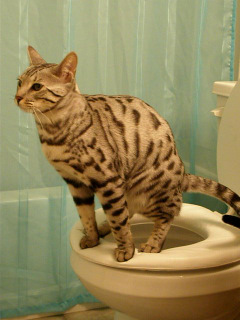We've encountered this article pertaining to How to Dispose of Cat Poop and Litter Without Plastic Bags below on the web and believe it made sense to discuss it with you in this article.

Intro
As feline owners, it's necessary to be mindful of how we deal with our feline buddies' waste. While it might seem convenient to purge pet cat poop down the toilet, this practice can have detrimental repercussions for both the environment and human wellness.
Ecological Impact
Flushing cat poop introduces damaging virus and bloodsuckers right into the water, posturing a considerable risk to aquatic ecological communities. These impurities can adversely affect marine life and compromise water high quality.
Health and wellness Risks
Along with environmental worries, purging feline waste can also posture wellness dangers to people. Cat feces may have Toxoplasma gondii, a bloodsucker that can cause toxoplasmosis-- a potentially extreme ailment, especially for expecting females and individuals with damaged immune systems.
Alternatives to Flushing
Fortunately, there are more secure and much more accountable ways to throw away feline poop. Think about the complying with options:
1. Scoop and Dispose in Trash
The most usual approach of dealing with feline poop is to scoop it right into a naturally degradable bag and toss it in the trash. Make certain to utilize a devoted clutter scoop and throw away the waste without delay.
2. Use Biodegradable Litter
Go with biodegradable pet cat clutter made from products such as corn or wheat. These clutters are eco-friendly and can be securely dealt with in the trash.
3. Hide in the Yard
If you have a yard, think about burying pet cat waste in a marked area away from vegetable yards and water resources. Be sure to dig deep adequate to stop contamination of groundwater.
4. Set Up a Pet Waste Disposal System
Invest in a pet dog waste disposal system especially designed for cat waste. These systems use enzymes to break down the waste, reducing smell and ecological impact.
Verdict
Liable animal possession extends past providing food and sanctuary-- it additionally includes appropriate waste monitoring. By refraining from flushing cat poop down the commode and going with alternate disposal approaches, we can minimize our environmental footprint and protect human health and wellness.
Why Can’t I Flush Cat Poop?
It Spreads a Parasite
Cats are frequently infected with a parasite called toxoplasma gondii. The parasite causes an infection called toxoplasmosis. It is usually harmless to cats. The parasite only uses cat poop as a host for its eggs. Otherwise, the cat’s immune system usually keeps the infection at low enough levels to maintain its own health. But it does not stop the develop of eggs. These eggs are tiny and surprisingly tough. They may survive for a year before they begin to grow. But that’s the problem.
Our wastewater system is not designed to deal with toxoplasmosis eggs. Instead, most eggs will flush from your toilet into sewers and wastewater management plants. After the sewage is treated for many other harmful things in it, it is typically released into local rivers, lakes, or oceans. Here, the toxoplasmosis eggs can find new hosts, including starfish, crabs, otters, and many other wildlife. For many, this is a significant risk to their health. Toxoplasmosis can also end up infecting water sources that are important for agriculture, which means our deer, pigs, and sheep can get infected too.
Is There Risk to Humans?
There can be a risk to human life from flushing cat poop down the toilet. If you do so, the parasites from your cat’s poop can end up in shellfish, game animals, or livestock. If this meat is then served raw or undercooked, the people who eat it can get sick.
In fact, according to the CDC, 40 million people in the United States are infected with toxoplasma gondii. They get it from exposure to infected seafood, or from some kind of cat poop contamination, like drinking from a stream that is contaminated or touching anything that has come into contact with cat poop. That includes just cleaning a cat litter box.
Most people who get infected with these parasites will not develop any symptoms. However, for pregnant women or for those with compromised immune systems, the parasite can cause severe health problems.
How to Handle Cat Poop
The best way to handle cat poop is actually to clean the box more often. The eggs that the parasite sheds will not become active until one to five days after the cat poops. That means that if you clean daily, you’re much less likely to come into direct contact with infectious eggs.
That said, always dispose of cat poop in the garbage and not down the toilet. Wash your hands before and after you clean the litter box, and bring the bag of poop right outside to your garbage bins.
https://trenchlesssolutionsusa.com/why-cant-i-flush-cat-poop/

We were made aware of that report on How to Dispose of Cat Poop and Litter Without Plastic Bags through someone on another blog. Kindly set aside a second to promote this article if you enjoyed it. I treasure reading our article about Don’t flush cat feces down the toilet.
Website